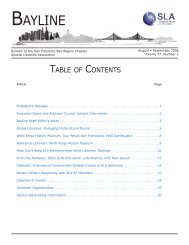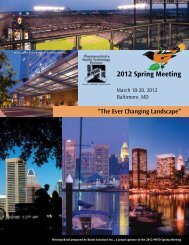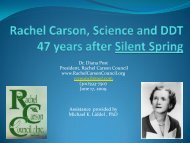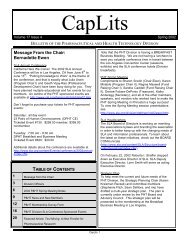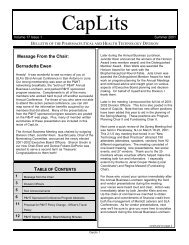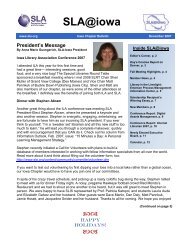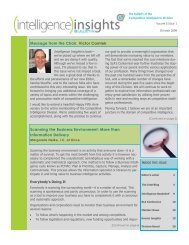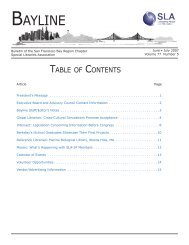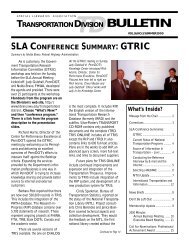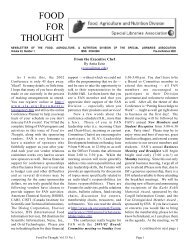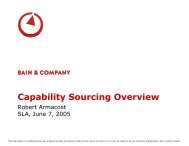Education Libraries - Special Libraries Association
Education Libraries - Special Libraries Association
Education Libraries - Special Libraries Association
You also want an ePaper? Increase the reach of your titles
YUMPU automatically turns print PDFs into web optimized ePapers that Google loves.
The Computer as an <strong>Education</strong>al Tool: Productivity<br />
and Problem Solving—Reviewed by Michelle Price<br />
Forcier, Richard C., and Descy, Don. E. The Computer<br />
as an <strong>Education</strong>al Tool: Productivity and Problem<br />
Solving, 5 th ed. Columbus, OH. Allyn & Bacon, 2008.<br />
ISBN: 0-1324-3396-6. $99.40.<br />
The fifth edition of The Computer as an <strong>Education</strong>al<br />
Tool: Productivity and Problem Solving separates the<br />
content into two parts, “Foundation and Theory” and<br />
“Classroom Applications as Learning Tools.” In the first<br />
part the text not only covers learning theory,<br />
management issues, technology standards, legal and<br />
ethically issues, but it also has a whole chapter devoted<br />
to learning about the computer. It covers hardware,<br />
software, networking, input devices, memory, etc. For<br />
the pre-service and even the in-service teacher, this<br />
chapter is invaluable for its layman’s approach to<br />
technical issues.<br />
Each chapter starts with a section of questions as the<br />
advanced organizer. There is also a chart to show which<br />
National <strong>Education</strong>al Technology Standards for teachers<br />
(NET-T) are addressed in each chapter. The chapters are<br />
filled with figures, charts, tutorials, snippets from real<br />
classrooms called “Let’s go into the classroom,” and<br />
then end with exercises and references to the companion<br />
website as well as a glossary of terms.<br />
The actual printed book is really just one part of the<br />
entire package. There is a companion website supported<br />
by Prentice Hall and a take along CD included with the<br />
book. Prentice Hall still maintains the website for the<br />
fourth edition as well as the companion site for the fifth<br />
edition. The site is navigable by chapters, and each<br />
chapter has objectives, summaries, self-assessment and<br />
essay questions. The self-assessments are multiple<br />
choice or true/false tests which include page number<br />
hints to find the answers in the text.<br />
There are nine other categories of online materials for<br />
the chapters; web resources, professional development,<br />
digital portfolio, standards, web extensions, demo<br />
central, activity central, supplemental information, and<br />
PowerPoint slides. Not every chapter has all nine<br />
categories available. The web extensions (web quests)<br />
and activity central provide more opportunities for<br />
student exercise. A very cool feature is the digital<br />
portfolio. For those institutions that support programs<br />
where pre-service and in-service teachers have to<br />
develop a digital portfolio, the website has activities for<br />
each chapter for creating portfolio pieces based on<br />
National <strong>Education</strong>al Technology Standards for Students<br />
(NET-S).<br />
The take-along CD contains PowerPoint slides for the<br />
chapters, tutorial files, guidelines, lessons and tech<br />
trends. Only the PowerPoint slides are available on the<br />
companion website, the others are exclusive to the CD.<br />
The data files for the lessons that contain Filemaker Pro<br />
and Excel are excellent and great time savers, but I ran<br />
into trouble when I was working on a thin client<br />
computer that had no CD drive! A likely reason for<br />
website exclusion is copyright restrictions since the<br />
guidelines and lesson figures are reproductions from the<br />
text. The tech trends are reprints of a regular column that<br />
the book editor, Don Descy, contributes to the<br />
TechTrends journal. A large portion of the TechTrends<br />
journal is available freely online, but the CD does not<br />
reference the journal website.<br />
I would be remiss if I did not bring up a few competing<br />
titles, Meaningful Learning with Technology (978-0-13-<br />
239395-9) covers a lot of the same topics but instead of<br />
organizing the book based on the tool, it splits chapters<br />
up by function, i.e. experimentation, communication,<br />
design. There is also Using Technology with Classroom<br />
Instruction that Works (978-1-4166-0570-6), published<br />
by the <strong>Association</strong> for Supervision and Curriculum<br />
Development and fashioned like the Marzano classics<br />
Classroom Management that Works and Classroom<br />
Instruction that Work. It covers computer applications<br />
tools and their use in the classroom.<br />
Overall all, The Computer as an <strong>Education</strong>al Tool :<br />
Productivity and Problem Solving should be a necessary<br />
requirement for teacher education because of its split<br />
focus on both theory and application and the depth of<br />
resources included with the companion site and the takealong<br />
CD . For any institution that does not have the<br />
fourth or fifth edition, I would suggest moving it to the<br />
top of your priority list for purchasing.<br />
Michelle Price is the Science and Outreach Librarian for<br />
St. John Fisher College in Rochester, New York. She<br />
previously reviewed books for <strong>Education</strong> <strong>Libraries</strong> as<br />
Michelle Dubaj, and up until this summer was Reference<br />
& Instruction Librarian at Reed Library, SUNY<br />
Fredonia, Fredonia, New York. Email: mprice@sjfc.edu<br />
<strong>Education</strong> <strong>Libraries</strong>, Volume 31, No. 2, Winter 2008 49



